Delaying an Electromagnetic Pulse with a Reflective High-Integration Meta-Platform
Abstract
:1. Introduction
2. New Concept for Delaying an EM Pulse by Integrated Meta-Device
3. Designs of the Integrated Meta-Device for Delaying an EM Pulse
4. Characterization of EM Pulse Delay Based on the Integrated Meta-Device
5. Conclusions
Supplementary Materials
Author Contributions
Funding
Data Availability Statement
Conflicts of Interest
Appendix A
References
- Krauss, T.F. Why Do We Need Slow Light? Nat. Photonics 2008, 2, 448–450. [Google Scholar] [CrossRef]
- Willner, A.E.; Zhang, B.; Zhang, L.; Yan, L.; Fazal, I. Optical Signal Processing Using Tunable Delay Elements Based on Slow Light. IEEE J. Sel. Top. Quantum Electron. 2008, 14, 691–705. [Google Scholar] [CrossRef]
- Corcoran, B.; Monat, C.; Grillet, C.; Moss, D.J.; Eggleton, B.J.; White, T.P.; O’Faolain, L.; Krauss, T.F. Green Light Emission in Silicon through Slow-Light Enhanced Third-Harmonic Generation in Photonic-Crystal Waveguides. Nat. Photonics 2009, 3, 206–210. [Google Scholar] [CrossRef]
- Xiao, S.; He, Q.; Huang, X.; Tang, S.; Zhou, L. Enhancement of Light-Matter Interactions in Slow-Wave Metasurfaces. Phys. Rev. B 2012, 85, 085125. [Google Scholar] [CrossRef]
- Ek, S.; Lunnemann, P.; Chen, Y.; Semenova, E.; Yvind, K.; Mork, J. Slow-Light-Enhanced Gain in Active Photonic Crystal Waveguides. Nat. Commun. 2014, 5, 5039. [Google Scholar] [CrossRef]
- Yan, S.; Zhu, X.; Frandsen, L.H.; Xiao, S.; Mortensen, N.A.; Dong, J.; Ding, Y. Slow-Light-Enhanced Energy Efficiency for Graphene Microheaters on Silicon Photonic Crystal Waveguides. Nat. Commun. 2017, 8, 14411. [Google Scholar] [CrossRef]
- Merilaita, S.; Scott-Samuel, N.E.; Cuthill, I.C. How Camouflage Works. Philos. Trans. R. Soc. B Biol. Sci. 2017, 372, 20160341. [Google Scholar] [CrossRef]
- Lee, H.; Chen, T.; Li, J.; Painter, O.; Vahala, K.J. Ultra-Low-Loss Optical Delay Line on a Silicon Chip. Nat. Commun. 2012, 3, 867. [Google Scholar] [CrossRef]
- Ji, X.; Yao, X.; Gan, Y.; Mohanty, A.; Tadayon, M.A.; Hendon, C.P.; Lipson, M. On-Chip Tunable Photonic Delay Line. APL Photonics 2019, 4, 090803. [Google Scholar] [CrossRef]
- Caucheteur, C.; Mussot, A.; Bette, S.; Kudlinski, A.; Douay, M.; Louvergneaux, E.; Mégret, P.; Taki, M.; Gonzảlez-Herrảez, M. All-Fiber Tunable Optical Delay Line. Opt. Express 2010, 18, 3093. [Google Scholar] [CrossRef]
- Dahan, D.; Eisenstein, G. Tunable All Optical Delay via Slow and Fast Light Propagation in a Raman Assisted Fiber Optical Parametric Amplifier: A Route to All Optical Buffering. Opt. Express 2005, 13, 6234. [Google Scholar] [CrossRef]
- Bigelow, M.S.; Lepeshkin, N.N.; Boyd, R.W. Observation of Ultraslow Light Propagation in a Ruby Crystal at Room Temperature. Phys. Rev. Lett. 2003, 90, 113903. [Google Scholar] [CrossRef]
- Kasapi, A.; Jain, M.; Yin, G.Y.; Harris, S.E. Electromagnetically Induced Transparency: Propagation Dynamics. Phys. Rev. Lett. 1995, 74, 2447–2450. [Google Scholar] [CrossRef]
- Hau, L.V.; Harris, S.E.; Dutton, Z.; Behroozi, C.H. Light Speed Reduction to 17 Metres per Second in an Ultracold Atomic Gas. Nature 1999, 397, 594–598. [Google Scholar] [CrossRef]
- Totsuka, K.; Kobayashi, N.; Tomita, M. Slow Light in Coupled-Resonator-Induced Transparency. Phys. Rev. Lett. 2007, 98, 213904. [Google Scholar] [CrossRef]
- Zhang, S.; Genov, D.A.; Wang, Y.; Liu, M.; Zhang, X. Plasmon-Induced Transparency in Metamaterials. Phys. Rev. Lett. 2008, 101, 047401. [Google Scholar] [CrossRef]
- Gu, J.; Singh, R.; Liu, X.; Zhang, X.; Ma, Y.; Zhang, S.; Maier, S.A.; Tian, Z.; Azad, A.K.; Chen, H.-T.; et al. Active Control of Electromagnetically Induced Transparency Analogue in Terahertz Metamaterials. Nat. Commun. 2012, 3, 1151. [Google Scholar] [CrossRef]
- Wang, X.; Zhou, L.; Li, R.; Xie, J.; Lu, L.; Wu, K.; Chen, J. Continuously Tunable Ultra-Thin Silicon Waveguide Optical Delay Line. Optica 2017, 4, 507. [Google Scholar] [CrossRef]
- Kim, T.-T.; Kim, H.-D.; Zhao, R.; Oh, S.S.; Ha, T.; Chung, D.S.; Lee, Y.H.; Min, B.; Zhang, S. Electrically Tunable Slow Light Using Graphene Metamaterials. ACS Photonics 2018, 5, 1800–1807. [Google Scholar] [CrossRef]
- Zhao, X.; Huang, R.; Du, X.; Zhang, Z.; Li, G. Ultrahigh-Q Metasurface Transparency Band Induced by Collective–Collective Coupling. Nano Lett. 2024, 24, 1238–1245. [Google Scholar] [CrossRef] [PubMed]
- Baba, T. Slow Light in Photonic Crystals. Nat. Photonics 2008, 2, 465–473. [Google Scholar] [CrossRef]
- Boyd, R.W. Material Slow Light and Structural Slow Light: Similarities and Differences for Nonlinear Optics. J. Opt. Soc. Am. B 2011, 28, A38. [Google Scholar] [CrossRef]
- Wang, X.; Zhao, Y.; Ding, Y.; Xiao, S.; Dong, J. Tunable Optical Delay Line Based on Integrated Grating-Assisted Contradirectional Couplers. Photonics Res. 2018, 6, 880. [Google Scholar] [CrossRef]
- Han, C.; Jin, M.; Tao, Y.; Shen, B.; Wang, X. Recent Progress in Silicon-Based Slow-Light Electro-Optic Modulators. Micromachines 2022, 13, 400. [Google Scholar] [CrossRef] [PubMed]
- Sun, X.-C.; Chen, H.; Lai, H.-S.; Xia, C.-H.; He, C.; Chen, Y.-F. Ideal Acoustic Quantum Spin Hall Phase in a Multi-Topology Platform. Nat. Commun. 2023, 14, 952. [Google Scholar] [CrossRef] [PubMed]
- Chen, G.; Wang, H.; Chen, B.; Ruan, Z.; Guo, C.; Chen, K.; Liu, L. Compact Slow-Light Waveguide and Modulator on Thin-Film Lithium Niobate Platform. Nanophotonics 2023, 12, 3603–3611. [Google Scholar] [CrossRef]
- Sun, S.; He, Q.; Hao, J.; Xiao, S.; Zhou, L. Electromagnetic Metasurfaces: Physics and Applications. Adv. Opt. Photonics 2019, 11, 380. [Google Scholar] [CrossRef]
- Yu, N.; Genevet, P.; Kats, M.A.; Aieta, F.; Tetienne, J.-P.; Capasso, F.; Gaburro, Z. Light Propagation with Phase Discontinuities: Generalized Laws of Reflection and Refraction. Science (1979) 2011, 334, 333–337. [Google Scholar] [CrossRef]
- Xu, Y.; Zhang, H.; Li, Q.; Zhang, X.; Xu, Q.; Zhang, W.; Hu, C.; Zhang, X.; Han, J.; Zhang, W. Generation of Terahertz Vector Beams Using Dielectric Metasurfaces via Spin-Decoupled Phase Control. Nanophotonics 2020, 9, 3393–3402. [Google Scholar] [CrossRef]
- Sun, S.; He, Q.; Xiao, S.; Xu, Q.; Li, X.; Zhou, L. Gradient-Index Meta-Surfaces as a Bridge Linking Propagating Waves and Surface Waves. Nat. Mater. 2012, 11, 426–431. [Google Scholar] [CrossRef]
- Li, S.; Wang, Z.; Dong, S.; Yi, S.; Guan, F.; Chen, Y.; Guo, H.; He, Q.; Zhou, L.; Sun, S. Helicity-Delinked Manipulations on Surface Waves and Propagating Waves by Metasurfaces. Nanophotonics 2020, 9, 3473–3481. [Google Scholar] [CrossRef]
- Sun, W.; He, Q.; Sun, S.; Zhou, L. High-Efficiency Surface Plasmon Meta-Couplers: Concept and Microwave-Regime Realizations. Light Sci. Appl. 2016, 5, e16003. [Google Scholar] [CrossRef]
- Chen, Y.; Zheng, X.; Zhang, X.; Pan, W.; Wang, Z.; Li, S.; Dong, S.; Liu, F.; He, Q.; Zhou, L.; et al. Efficient Meta-Couplers Squeezing Propagating Light into On-Chip Subwavelength Devices in a Controllable Way. Nano Lett. 2023, 23, 3326–3333. [Google Scholar] [CrossRef] [PubMed]
- Khorasaninejad, M.; Chen, W.T.; Devlin, R.C.; Oh, J.; Zhu, A.Y.; Capasso, F. Metalenses at Visible Wavelengths: Diffraction-Limited Focusing and Subwavelength Resolution Imaging. Science (1979) 2016, 352, 1190–1194. [Google Scholar] [CrossRef]
- Wang, S.; Wu, P.C.; Su, V.-C.; Lai, Y.-C.; Hung Chu, C.; Chen, J.-W.; Lu, S.-H.; Chen, J.; Xu, B.; Kuan, C.-H.; et al. Broadband Achromatic Optical Metasurface Devices. Nat. Commun. 2017, 8, 187. [Google Scholar] [CrossRef] [PubMed]
- Wang, Y.; Chen, Q.; Yang, W.; Ji, Z.; Jin, L.; Ma, X.; Song, Q.; Boltasseva, A.; Han, J.; Shalaev, V.M.; et al. High-Efficiency Broadband Achromatic Metalens for near-IR Biological Imaging Window. Nat. Commun. 2021, 12, 5560. [Google Scholar] [CrossRef]
- Ma, H.F.; Cui, T.J. Three-Dimensional Broadband Ground-Plane Cloak Made of Metamaterials. Nat. Commun. 2010, 1, 21. [Google Scholar] [CrossRef]
- Chu, H.; Li, Q.; Liu, B.; Luo, J.; Sun, S.; Hang, Z.H.; Zhou, L.; Lai, Y. A Hybrid Invisibility Cloak Based on Integration of Transparent Metasurfaces and Zero-Index Materials. Light Sci. Appl. 2018, 7, 50. [Google Scholar] [CrossRef]
- Huang, L.; Chen, X.; Mühlenbernd, H.; Zhang, H.; Chen, S.; Bai, B.; Tan, Q.; Jin, G.; Cheah, K.-W.; Qiu, C.-W.; et al. Three-Dimensional Optical Holography Using a Plasmonic Metasurface. Nat. Commun. 2013, 4, 2808. [Google Scholar] [CrossRef]
- Li, X.; Ren, H.; Chen, X.; Liu, J.; Li, Q.; Li, C.; Xue, G.; Jia, J.; Cao, L.; Sahu, A.; et al. Athermally Photoreduced Graphene Oxides for Three-Dimensional Holographic Images. Nat. Commun. 2015, 6, 6984. [Google Scholar] [CrossRef]
- Zheng, G.; Mühlenbernd, H.; Kenney, M.; Li, G.; Zentgraf, T.; Zhang, S. Metasurface Holograms Reaching 80% Efficiency. Nat. Nanotechnol. 2015, 10, 308–312. [Google Scholar] [CrossRef] [PubMed]
- Gan, Q.; Fu, Z.; Ding, Y.J.; Bartoli, F.J. Ultrawide-Bandwidth Slow-Light System Based on THz Plasmonic Graded Metallic Grating Structures. Phys. Rev. Lett. 2008, 100, 256803. [Google Scholar] [CrossRef] [PubMed]
- Hu, H.; Ji, D.; Zeng, X.; Liu, K.; Gan, Q. Rainbow Trapping in Hyperbolic Metamaterial Waveguide. Sci. Rep. 2013, 3, 1249. [Google Scholar] [CrossRef]
- Yang, Y.; Shen, X.; Zhao, P.; Zhang, H.C.; Cui, T.J. Trapping Surface Plasmon Polaritons on Ultrathin Corrugated Metallic Strips in Microwave Frequencies. Opt. Express 2015, 23, 7031. [Google Scholar] [CrossRef]
- Pan, W.; Wang, Z.; Chen, Y.; Li, S.; Zheng, X.; Tian, X.; Chen, C.; Xu, N.; He, Q.; Zhou, L.; et al. High-Efficiency Generation of Far-Field Spin-Polarized Wavefronts via Designer Surface Wave Metasurfaces. Nanophotonics 2022, 11, 2025–2036. [Google Scholar] [CrossRef]
- Huang, L.; Chen, X.; Bai, B.; Tan, Q.; Jin, G.; Zentgraf, T.; Zhang, S. Helicity Dependent Directional Surface Plasmon Polariton Excitation Using a Metasurface with Interfacial Phase Discontinuity. Light Sci. Appl. 2013, 2, e70. [Google Scholar] [CrossRef]
- Duan, J.; Guo, H.; Dong, S.; Cai, T.; Luo, W.; Liang, Z.; He, Q.; Zhou, L.; Sun, S. High-Efficiency Chirality-Modulated Spoof Surface Plasmon Meta-Coupler. Sci. Rep. 2017, 7, 1354. [Google Scholar] [CrossRef]
- Luo, W.; Sun, S.; Xu, H.-X.; He, Q.; Zhou, L. Transmissive Ultrathin Pancharatnam-Berry Metasurfaces with Nearly 100% Efficiency. Phys. Rev. Appl. 2017, 7, 044033. [Google Scholar] [CrossRef]
- Luo, W.; Xiao, S.; He, Q.; Sun, S.; Zhou, L. Photonic Spin Hall Effect with Nearly 100% Efficiency. Adv. Opt. Mater. 2015, 3, 1102–1108. [Google Scholar] [CrossRef]
- Sievenpiper, D.; Zhang, L.; Broas, R.F.J.; Alexopolous, N.G.; Yablonovitch, E. High-Impedance Electromagnetic Surfaces with a Forbidden Frequency Band. IEEE Trans. Microw. Theory Tech. 1999, 47, 2059–2074. [Google Scholar] [CrossRef]
- Shen, X.; Cui, T.J.; Martin-Cano, D.; Garcia-Vidal, F.J. Conformal Surface Plasmons Propagating on Ultrathin and Flexible Films. Proc. Natl. Acad. Sci. USA 2013, 110, 40–45. [Google Scholar] [CrossRef] [PubMed]
- Tang, W.X.; Zhang, H.C.; Ma, H.F.; Jiang, W.X.; Cui, T.J. Concept, Theory, Design, and Applications of Spoof Surface Plasmon Polaritons at Microwave Frequencies. Adv. Opt. Mater. 2019, 7, 1800421. [Google Scholar] [CrossRef]
- Guan, F.; Sun, S.; Ma, S.; Fang, Z.; Zhu, B.; Li, X.; He, Q.; Xiao, S.; Zhou, L. Transmission/Reflection Behaviors of Surface Plasmons at an Interface between Two Plasmonic Systems. J. Phys. Condens. Matter 2018, 30, 114002. [Google Scholar] [CrossRef] [PubMed]
- Zhu, B.; Tang, S.; Zhou, L. Effective Medium Theory for Subwavelength Cylinder Arrays. Europhys. Lett. 2016, 113, 48002. [Google Scholar] [CrossRef]
- Ma, H.F.; Shen, X.; Cheng, Q.; Jiang, W.X.; Cui, T.J. Broadband and High-Efficiency Conversion from Guided Waves to Spoof Surface Plasmon Polaritons. Laser Photonics Rev. 2014, 8, 146–151. [Google Scholar] [CrossRef]
- Povinelli, M.L.; Johnson, S.G.; Joannopoulos, J.D. Slow-Light, Band-Edge Waveguides for Tunable Time Delays. Opt Express 2005, 13, 7145. [Google Scholar] [CrossRef]
- Sun, S.; Yang, K.-Y.; Wang, C.-M.; Juan, T.-K.; Chen, W.T.; Liao, C.Y.; He, Q.; Xiao, S.; Kung, W.-T.; Guo, G.-Y.; et al. High-Efficiency Broadband Anomalous Reflection by Gradient Meta-Surfaces. Nano Lett. 2012, 12, 6223–6229. [Google Scholar] [CrossRef]
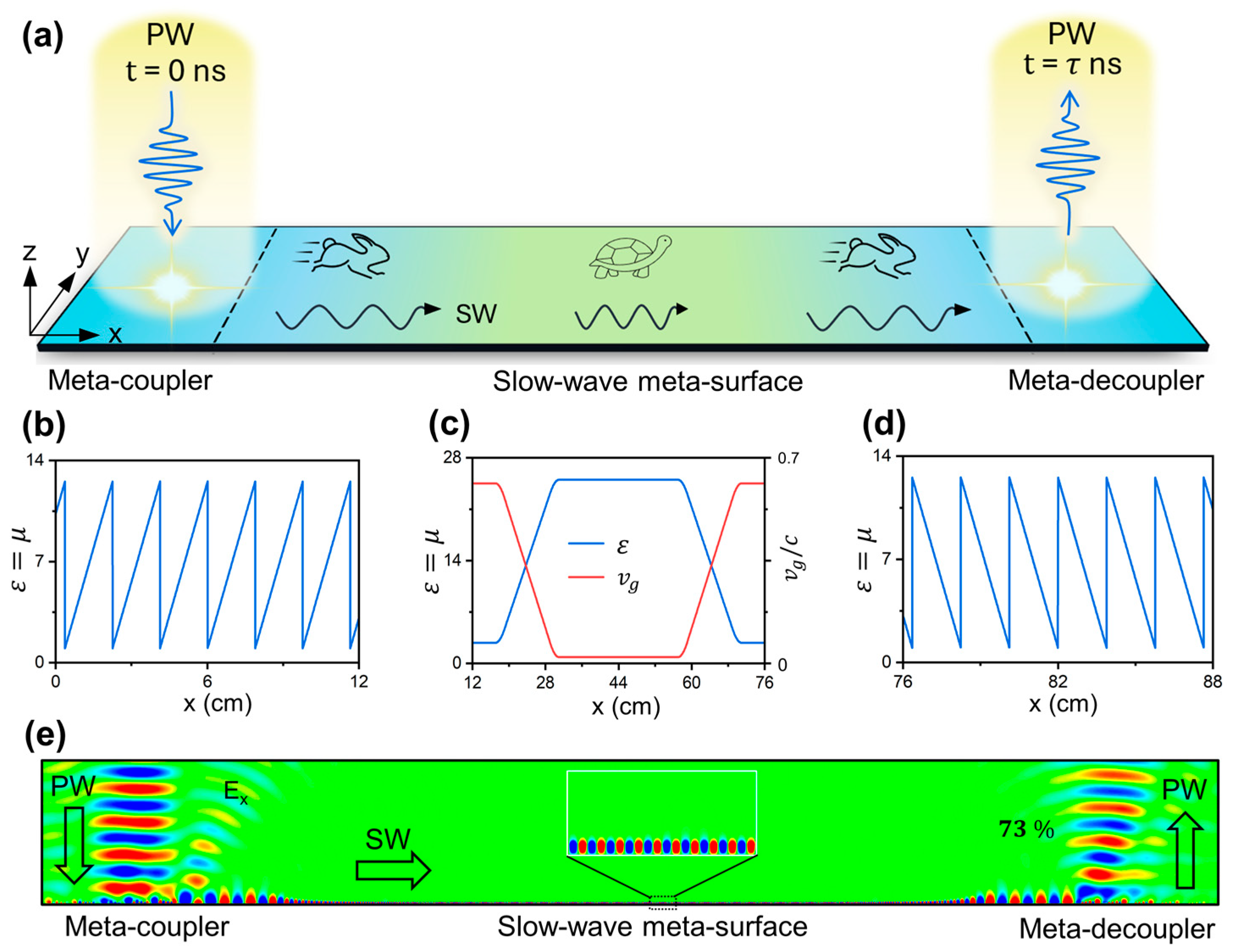
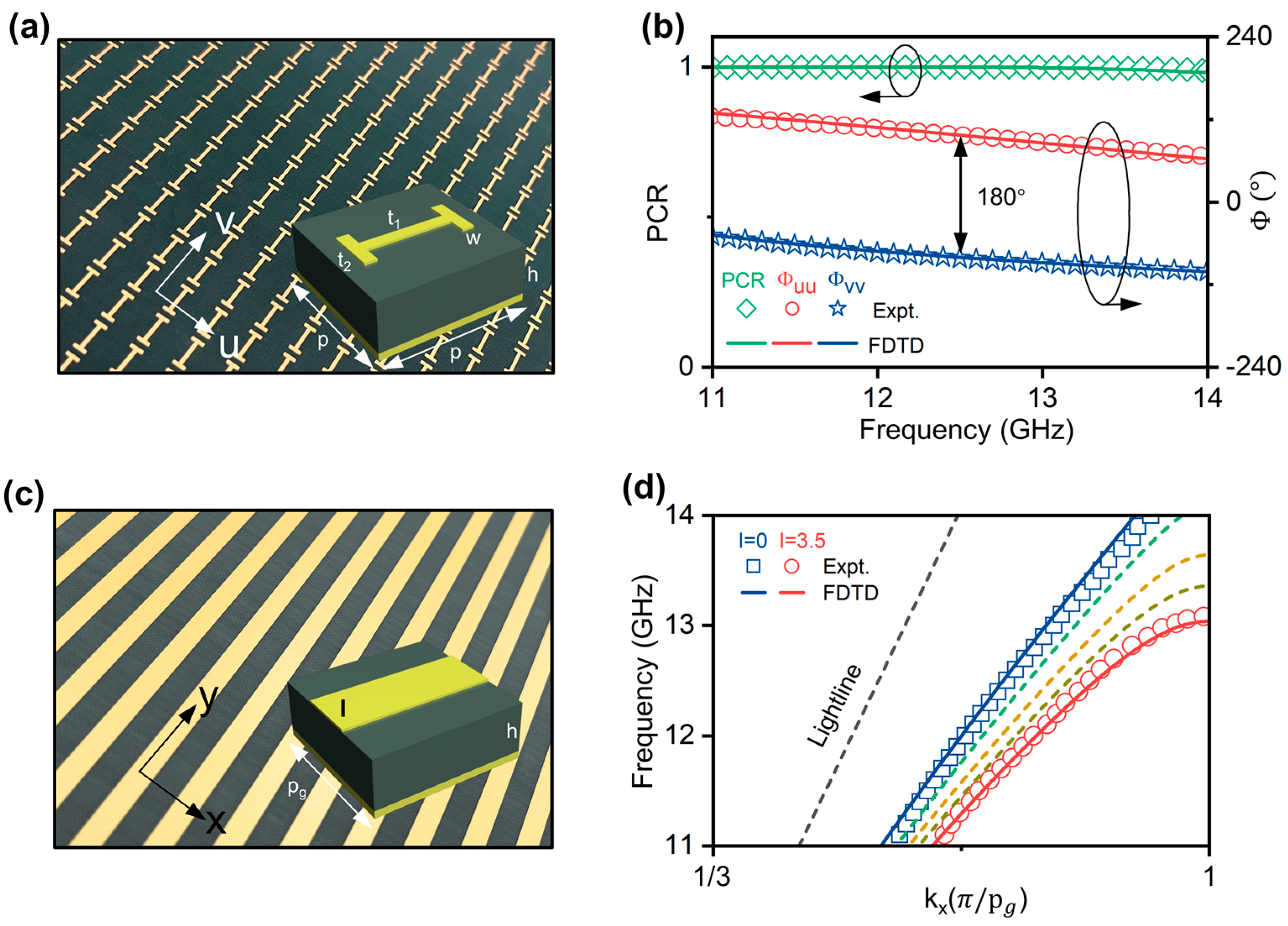

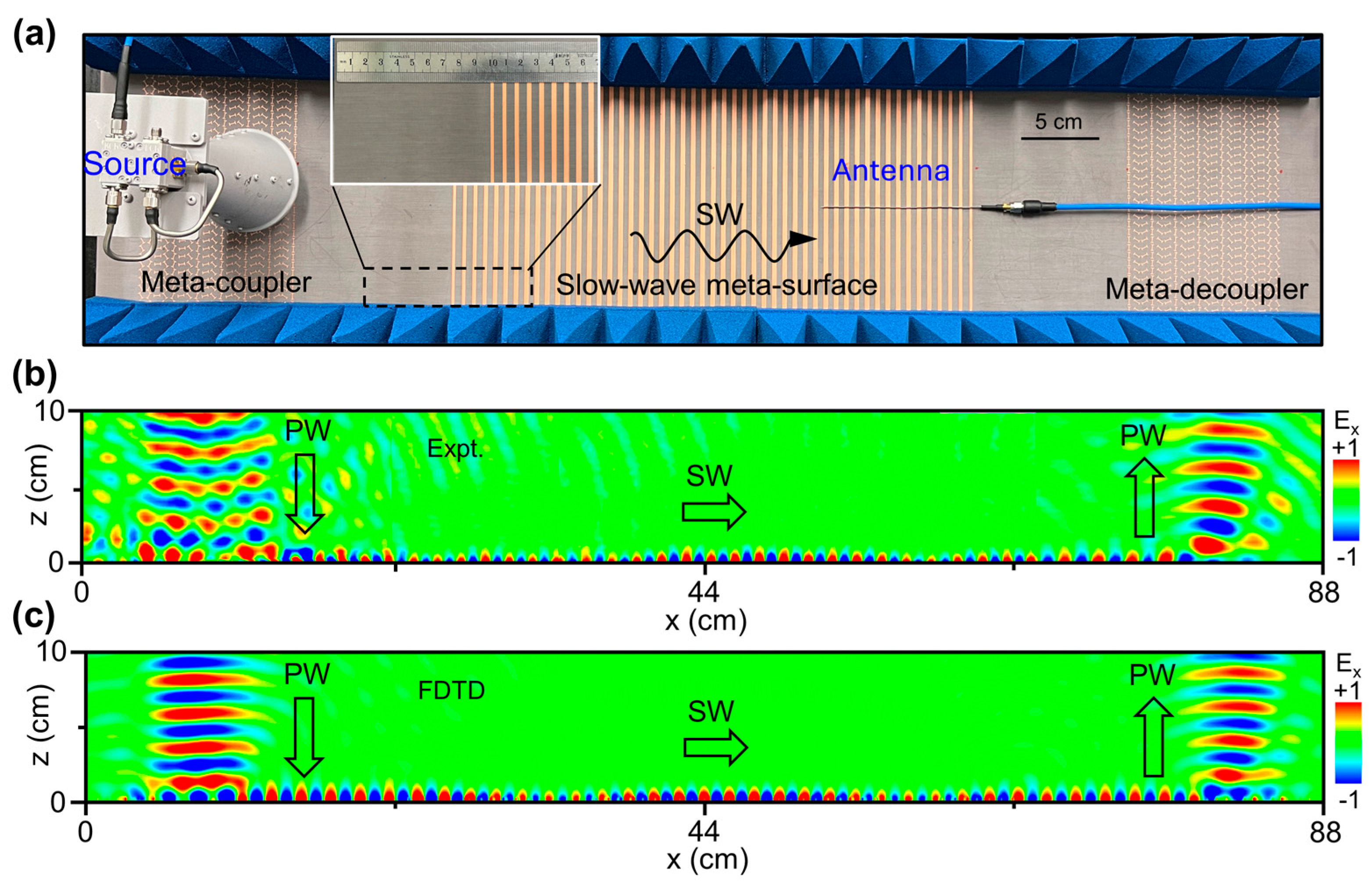
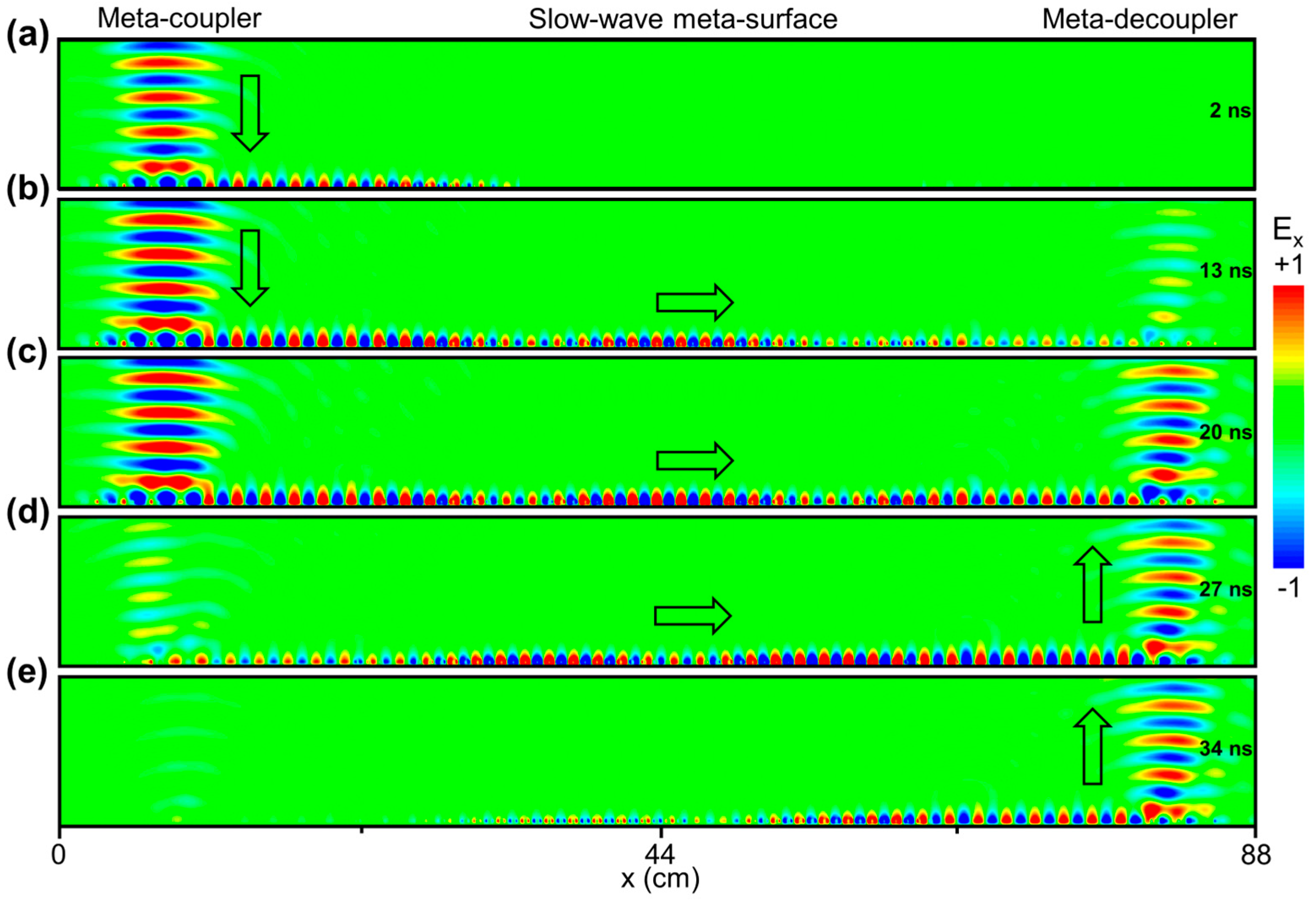
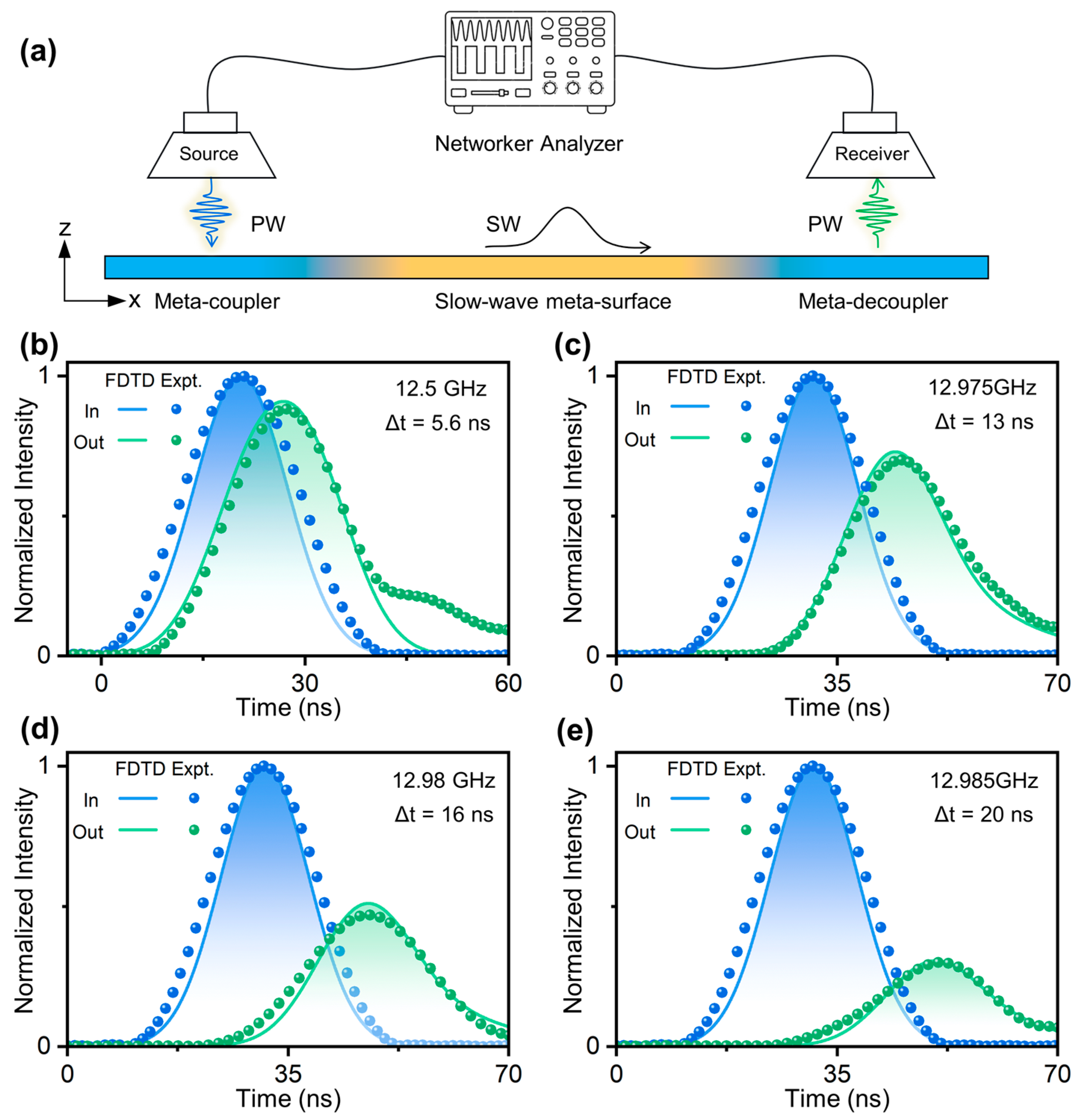
Disclaimer/Publisher’s Note: The statements, opinions and data contained in all publications are solely those of the individual author(s) and contributor(s) and not of MDPI and/or the editor(s). MDPI and/or the editor(s) disclaim responsibility for any injury to people or property resulting from any ideas, methods, instructions or products referred to in the content. |
© 2024 by the authors. Licensee MDPI, Basel, Switzerland. This article is an open access article distributed under the terms and conditions of the Creative Commons Attribution (CC BY) license (https://creativecommons.org/licenses/by/4.0/).
Share and Cite
Li, L.; Pan, W.; Wang, Y.; Jin, X.; Chen, Y.; Zhu, Z.; Liu, M.; Li, J.; Shi, Y.; Li, H.; et al. Delaying an Electromagnetic Pulse with a Reflective High-Integration Meta-Platform. Nanomaterials 2024, 14, 1438. https://doi.org/10.3390/nano14171438
Li L, Pan W, Wang Y, Jin X, Chen Y, Zhu Z, Liu M, Li J, Shi Y, Li H, et al. Delaying an Electromagnetic Pulse with a Reflective High-Integration Meta-Platform. Nanomaterials. 2024; 14(17):1438. https://doi.org/10.3390/nano14171438
Chicago/Turabian StyleLi, Liangwei, Weikang Pan, Yingying Wang, Xiangyu Jin, Yizhen Chen, Zhiyan Zhu, Muhan Liu, Jianru Li, Yang Shi, Haodong Li, and et al. 2024. "Delaying an Electromagnetic Pulse with a Reflective High-Integration Meta-Platform" Nanomaterials 14, no. 17: 1438. https://doi.org/10.3390/nano14171438




